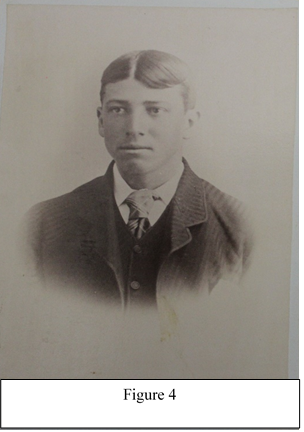
Lesley Smith’s Family Photographs
Lesley Smith inherited two leather photograph albums from her family that contain several snaps. She brought eight photographs from the album to our History Harvest on family photographs in 2019 to showcase some of her favourites, including one of her grandfather and his three brothers (Figure 1). Her grandfather posed, standing behind a stool while his brothers were seated on either side. Lesley’s fascination with her family’s history and the photographs stemmed in part because her maiden name is Matters and she was curious to know if she was related to the suffragette, Muriel Matters. While she was unable to prove a connection between herself and Muriel, Lesley remains enthusiastic about the photographs and their ability to connect her with the family. The main challenge Lesley faced with learning about her family from the photographs is that most of them were not labelled with dates or the names of subjects. With very little other information to base her research on, Lesley found that she could not identify many of her relatives.
Historian Annette Kuhn provides a useful method for analysing photographs and understanding the significance of their cultural memory, which can also help to situated them in their broader historical context:
- Observe and describe the human subjects in the photograph. Then ‘take up the position’ of subjects in the photograph by imagining oneself as them.
- Analyse the picture’s context of production: where, when, why, and by whom was the photograph taken?
- Consider the wider context in which the photograph was created: what techniques were used? Does it conform to contemporary conventions?
- Evaluate the photograph’s ‘currency’ in its reception: Who was the photograph made for? Who has it now and where is it kept? Who saw it then and who sees it now?[1]
[1] Annette Kuhn, ‘Photography and Cultural Memory: A Methodological Exploration’, Visual Studies, 22:3 (2007), 284.
Observing the attire that was worn in photographs helped Lesley to roughly date them—for example, she believes that two photographs of women were from the 1880s based on their headgear, but could still not pinpoint exactly how these women were related. Otherwise, she found that researching the photographers whose names appeared underneath or behind the portraits helped to create a tighter date range. By tracing the names of photographers in Trove, and when they were prolific, I could also narrow down when certain photographs were taken. For example, one photograph was taken at T. Duryea’s studio on 158a Rundle St (Figure 2). Although the studio was initially established in 1854, the address included on the photograph confines the likely timeline of its creation to between 1876 and 1920, as the original studio was built in King William St before it was destroyed by fire in 1875.[2] Similarly, a portrait by F. Scott Broad (Figure 3) can be dated roughly between the years of 1890-1899, as this was when his studio operated in Moonta.
If no photographer was named, this made contextualising the photograph trickier. In the case of one snap of a boy (Figure 4), with no trademarks or labels, she knew that he was the grandson of a relation, but had no further leads to identify him.
While the photographs offered more questions than answers for Lesley about her family, she still gets joy from her collection. Professor of Photography Studies, Mette Sandbye suggests family photographs are ‘social and dynamic’ objects which have emotional and psychological qualities that influence people other than their original owners.[3] She states that these objects, especially when compiled as albums, create links between people and evoke memory in relation to separation and nostalgia.[4] The family album, while it was not initially created for Lesley, has important significance in providing a connection to her distant relatives and providing interesting insights, such as what their faces looked like and kinds of clothes they wore in different time periods. She stated at the end of our interview: ‘I just think [photographs are] a wonderful way of saving history … You’re able to learn a lot from them’.



[1] Annette Kuhn, ‘Photography and Cultural Memory: A Methodological Exploration’, Visual Studies, 22:3 (2007), 284.
[2] https://trove.nla.gov.au/newspaper/article/40092359?searchTerm=%22duryea%22%20photograph*.
[3] Mette Sandbye, ‘Looking at the family photo album: a resumed theoretical discussion of why and how’, Journal of Aesthetics & Culture, 6:1 (2014), 2.
[4] Mette Sandbye, ‘Looking at the family photo album: a resumed theoretical discussion of why and how’, Journal of Aesthetics & Culture, 6:1 (2014), 13.